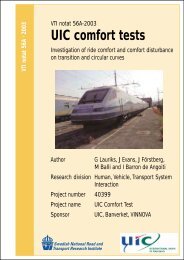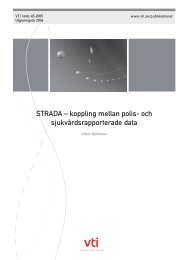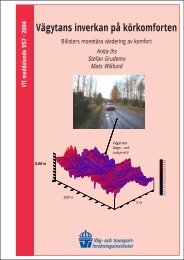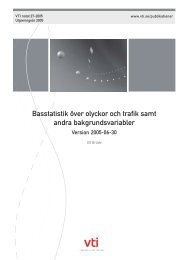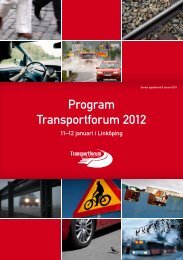cykelvägars drift-och underhållsstandard –kommunenkät - VTI
cykelvägars drift-och underhållsstandard –kommunenkät - VTI
cykelvägars drift-och underhållsstandard –kommunenkät - VTI
You also want an ePaper? Increase the reach of your titles
YUMPU automatically turns print PDFs into web optimized ePapers that Google loves.
Maintenance service levels of cycleways. Interviews with 13 Swedish municipalities<br />
with relatively high amount of bicycle traffic.<br />
by Anna Niska<br />
<strong>VTI</strong> (Swedish National Road and Transport Research Institute)<br />
SE-581 95 Linköping Sweden<br />
Summary<br />
This study gives an insight into the routines and regulations for cycleway maintenance<br />
in Swedish municipalities with relatively high amount of bicycle traffic. The study is<br />
part of a larger project “Service levels of cycleways” with the purpose of finding the<br />
characteristics of an attractive cycleway, and specifying how to maintain cycleways in<br />
order to promote cycling. The study is based on interviews with employees in 13<br />
Swedish municipalities supplemented with relevant documentation provided by them.<br />
In general, for cycleway construction, Swedish municipalities follow the technical<br />
description of road constructions from the Swedish Road Administration (SRA).<br />
However, for maintenance and operation of cycle ways, the municipalities have their<br />
own requirements. The local conditions are considered to vary to a degree demanding<br />
specific requirements for each municipality. Usually, budget restraints are determining<br />
maintenance requirements and when measures are taken. In a majority of the<br />
municipalities interviewed, cycle ways are given priority and are maintained at the<br />
highest service level. Maintenance measures are performed by the municipalities them<br />
selves or by contractors.<br />
Thawing and freezing, resulting in slush followed, alternately, by icy ruts and<br />
slipperiness, is considered to be the most difficult condition to handle in cycleway<br />
maintenance. Providing good quality surfaces in view of cyclists’ sensitivity to even<br />
minor defects, is also considered to be difficult. Many of the interviewed emphasized<br />
that limited means is the largest problem making it increasingly difficult to provide a<br />
high maintenance service level.<br />
In general, cycleway surface conditions are monitored through visual inspections only.<br />
The public is considered to be an important resource in detecting and reporting<br />
potholes, cracks and other cycleway defects, and the municipalities systematically<br />
register remarks from the public. The most common complaints from the public<br />
concerning cycleway maintenance, regard broken glass or slipperiness. Other concerns<br />
are also reflected such as requests for new cycle paths, unclear traffic regulations and<br />
traffic behaviour where different groups of road-users are complaining about the<br />
behaviour of others.<br />
A continuous cycleway network separated from car traffic and a high maintenance<br />
service level are considered to be the most important measures in order to promote<br />
cycling and simultaneously improve cycling safety. It is also considered important to<br />
raise the status of the bicycle as a means of transport, to elucidate traffic regulations<br />
including cyclists, and to increase the respect among road-users. It is the overall<br />
resolution combining several measures that is important when improving the situation<br />
of cyclists.<br />
It is important to support the municipal road administrators with cost-benefit arguments<br />
presenting the total cost of bicycle accidents, travelling time, etc., in order to get<br />
funding for maintenance measures. On the other hand, it is possible to improve the<br />
<strong>VTI</strong> rapport 558 7



